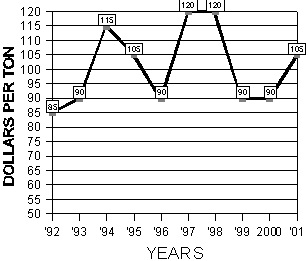Alfalfa Report
Yuma County, Arizona
December 31, 2001
Yuma County Office
2200 W. 28th Street, Ste. 102
Yuma, AZ 85364
(928) 726-3904
(928) 726-8472 FAX
Production Update:
PDF version, 60KB
Winter Irrigation: Alfalfa water use from November through February averages about 3.5 inches per month in the low elevation desert areas. Winter rainfall cannot usually sustain maximum production in these areas and some supplemental irrigation is required. If we assume an irrigation efficiency of 0.7, then a single 5-inch irrigation every month can meet alfalfa water requirements during the winter on average. The actual irrigation requirement depends on soil type, weather conditions, rainfall, growth of the crop, and other factors. Growers sometimes use the winter as a time to replenish subsoil moisture and apply more water than is actually required by the crop during this time of the year.
Insect Management: Spotted alfalfa aphid caused severe damage to alfalfa in Arizona and California in the 1950s. A combination of introduced parasites and host plant resistance brought this pest under control. The host plant resistant developed by Dr. William Lehman and Dr. Merv Nielson are still the basis for aphid resistant alfalfa varieties used today. Spotted alfalfa aphid still occasionally causes problems, but generally only when susceptible cultivars are grown. Since 1996, spotted alfalfa aphid has occasionally appeared in damaging numbers in highly resistant alfalfa varieties. The reasons for the appearance of this aphid in highly resistant cultivars is being investigated. There is every reason to believe that the highly resistant cultivars will continue to keep the spotted alfalfa aphid in check along with the indigenous and introduced natural enemies. Spotted alfalfa aphid develops better under warm temperatures than pea aphid or blue alfalfa aphid.
Weed Control: Pursuit will control almost all broadleaf weeds
except for sowthistle and goosefoot. When these are present, it may be
best to also use two 4-DB (Butyrac, Butoxone). Follow label directions
on the size of crop required at application.
| Market Summary |
High
|
Low
|
Average
|
Off grade
|
| Past 2 Weeks (Dec 18, 2001 to Dec 31, 2001) |
110
|
100
|
105
|
90-100
|
| Last Year (Dec 18, 2001 to Dec 31, 2000) |
105
|
90
|
100
|
70-90
|
10 Year Summary (Dec 18 to Dec 31, 1992-2001):

Issued in furtherance of Cooperative Extension work, acts of May 8 and June 30, 1914, in cooperation with the U.S. Department of Agriculture, James A. Christenson, Director Cooperative Extension, College of Agriculture and Life Sciences, The University of Arizona.
The University of Arizona is an equal opportunity, affirmative action institution. The University does not discriminate on the basis of race, color, religion, sex, national origin, age, disability, veteran status, or sexual orientation in its programs and activities.
Any products, services, or organizations that are
mentioned, shown, or indirectly implied in this web document do not imply
endorsement by The University of Arizona.
Information provided by:
Barry Tickes, btickes@ag.arizona.edu Extension Agent, Yuma County
Michael Ottman, mottman@ag.arizona.edu Agronomy Specialist
College of Agriculture, The University of Arizona.
Eric Natwick, etnatwick@ucdavis.edu UCCE Imperial County - Farm Advisor
University of California, Davis, CA.
Material written December 31, 2001.
Forages: Crop Mgmt | Soil Mgmt | Irrigation | Alfalfa Reports | Insects | Diseases | Weeds | Pesticides
Home | Other Crops | Forages
For more Arizona Production Ag Information:
Home | Cotton | Veggies| Forages | Grains | Citrus | Crop x Crop | Insects | Diseases| Weeds | Pesticides | News | Weather | Research | Photos | Contacts | General Info. | Site Map
Copyright © 2001 University of Arizona,
College of Agriculture and Life Sciences
Webmaster: Al Fournier (fournier@ag.arizona.edu)